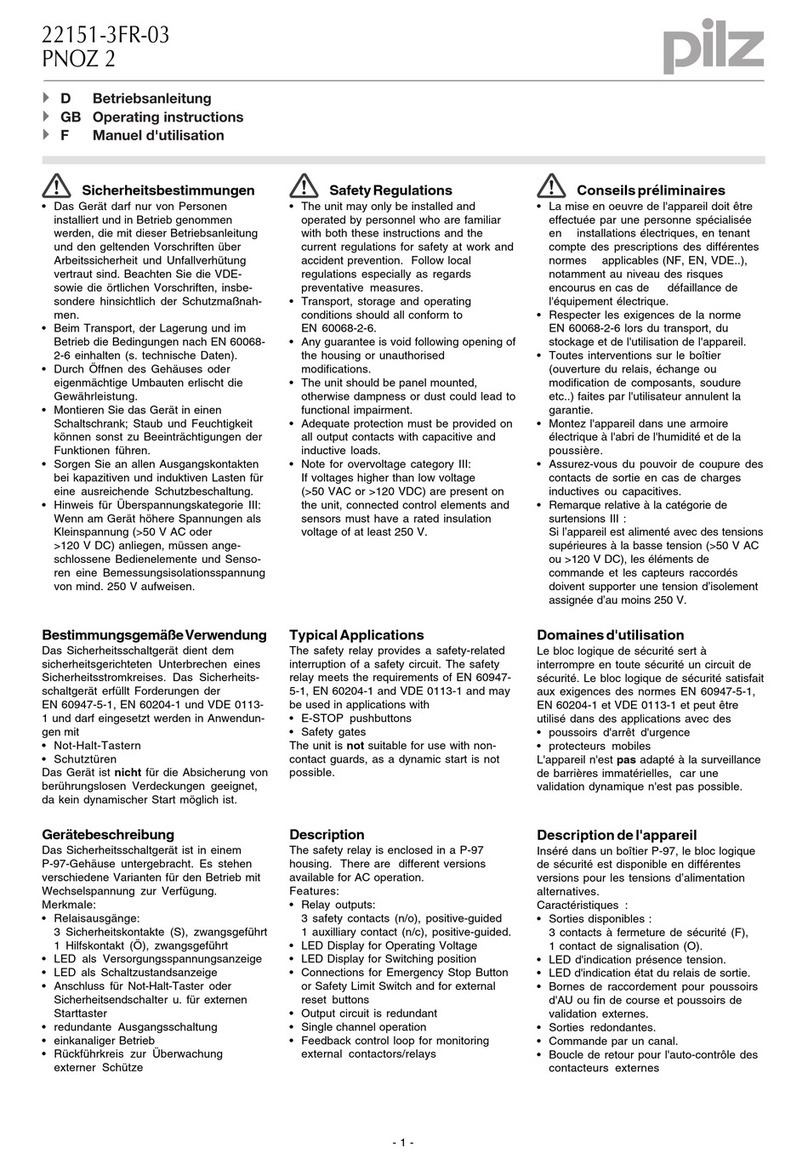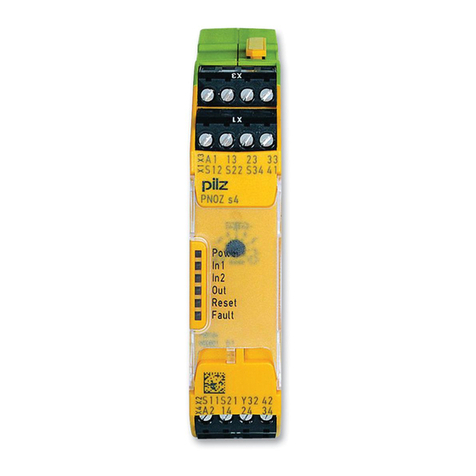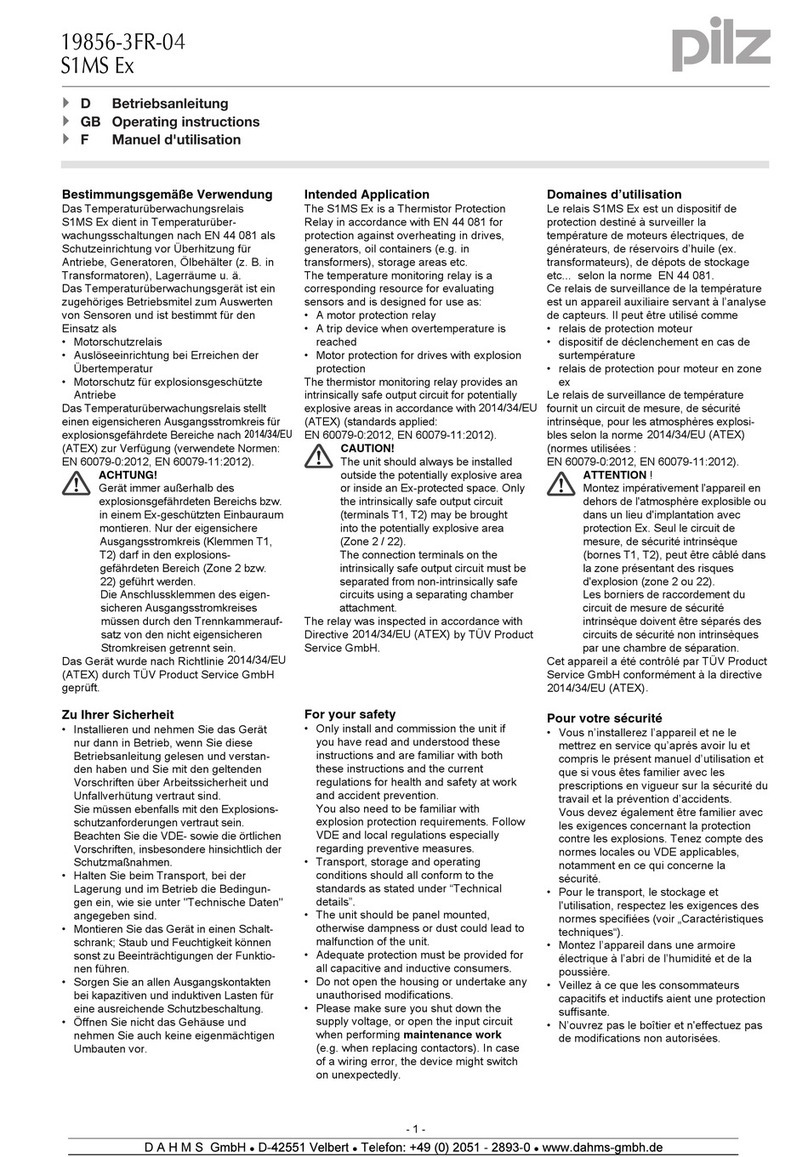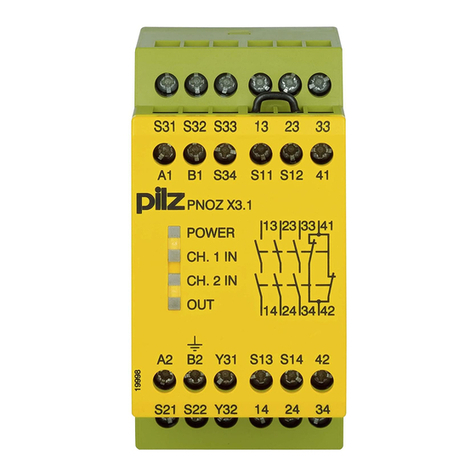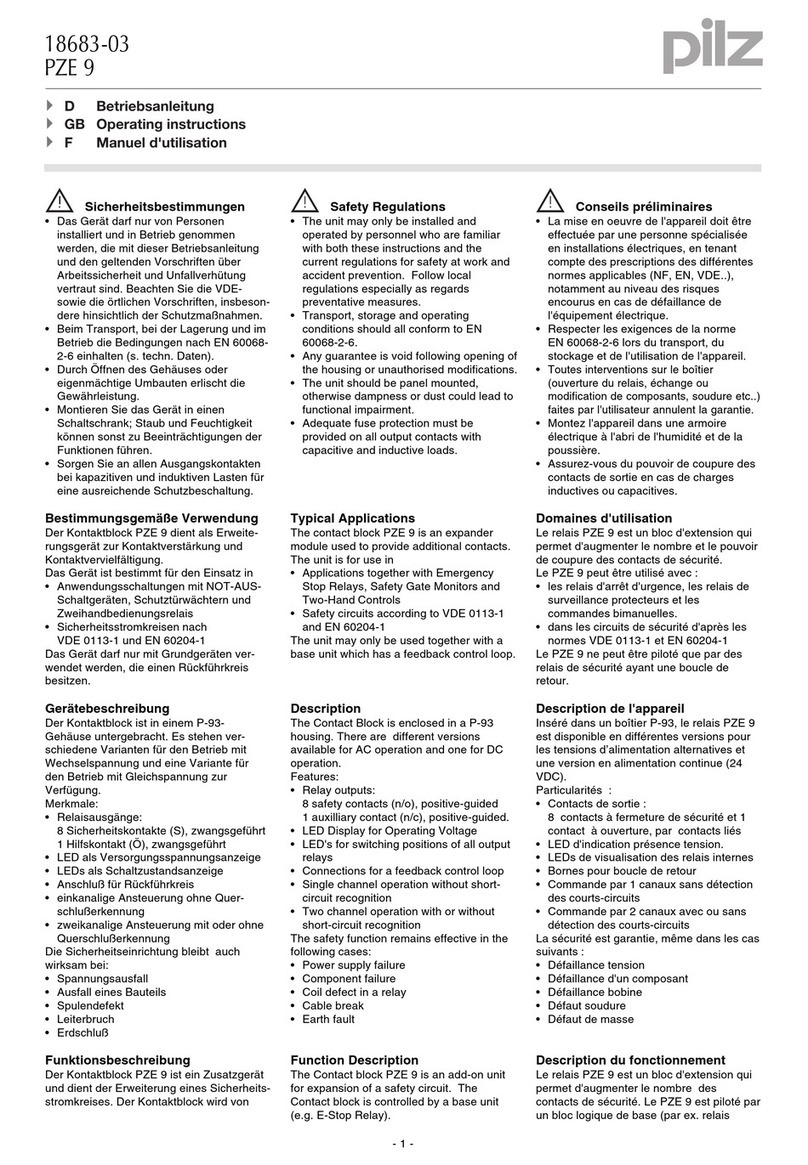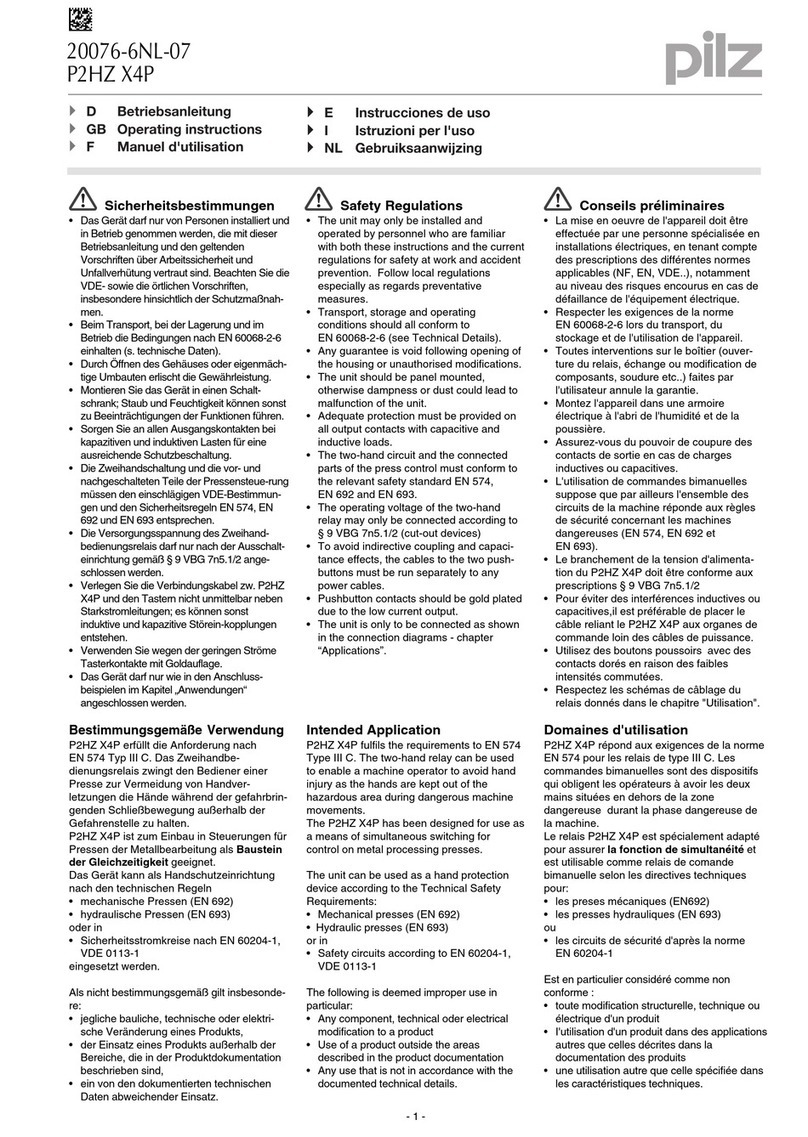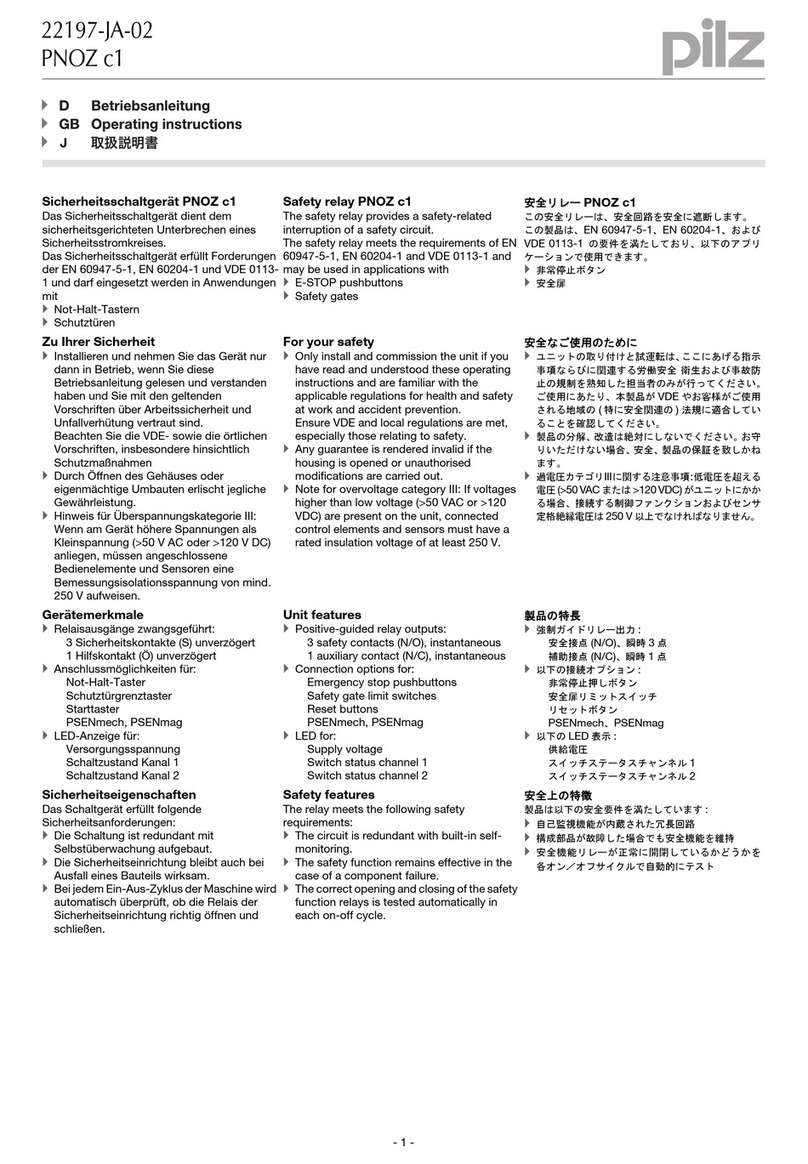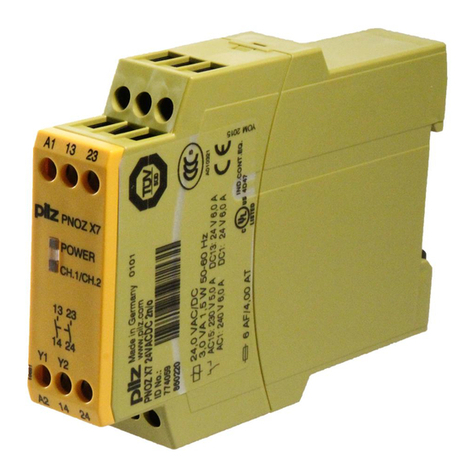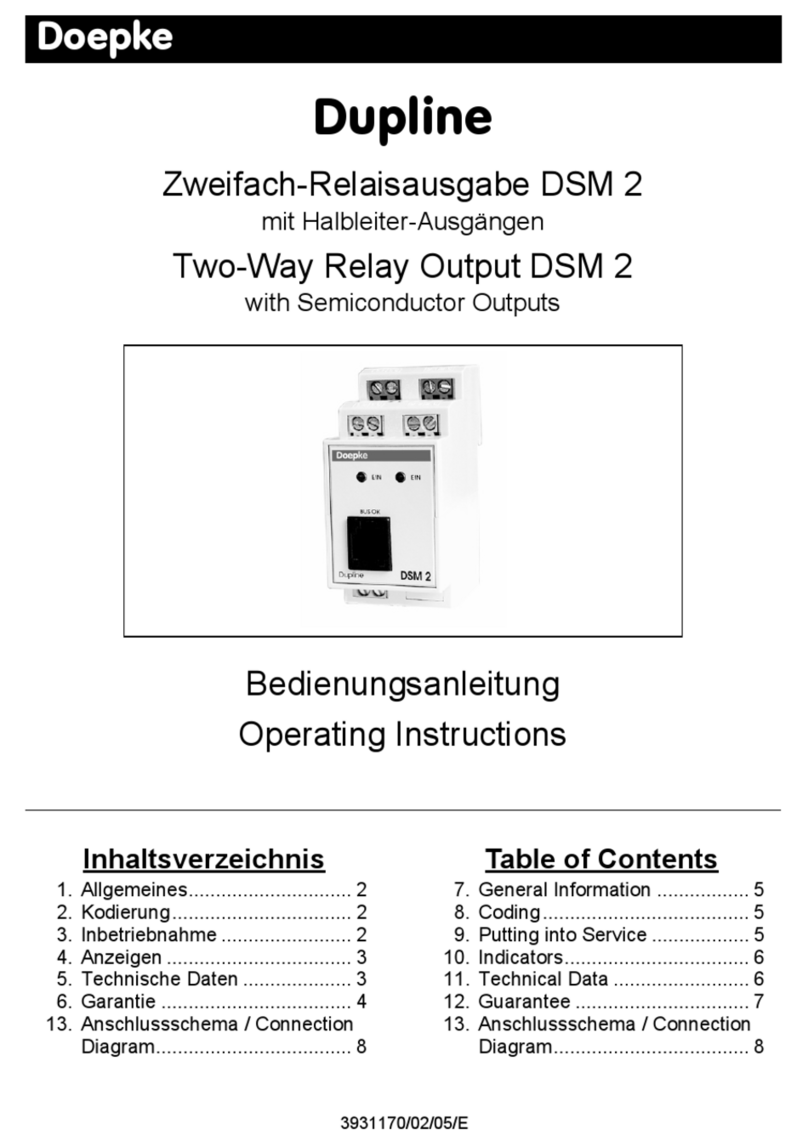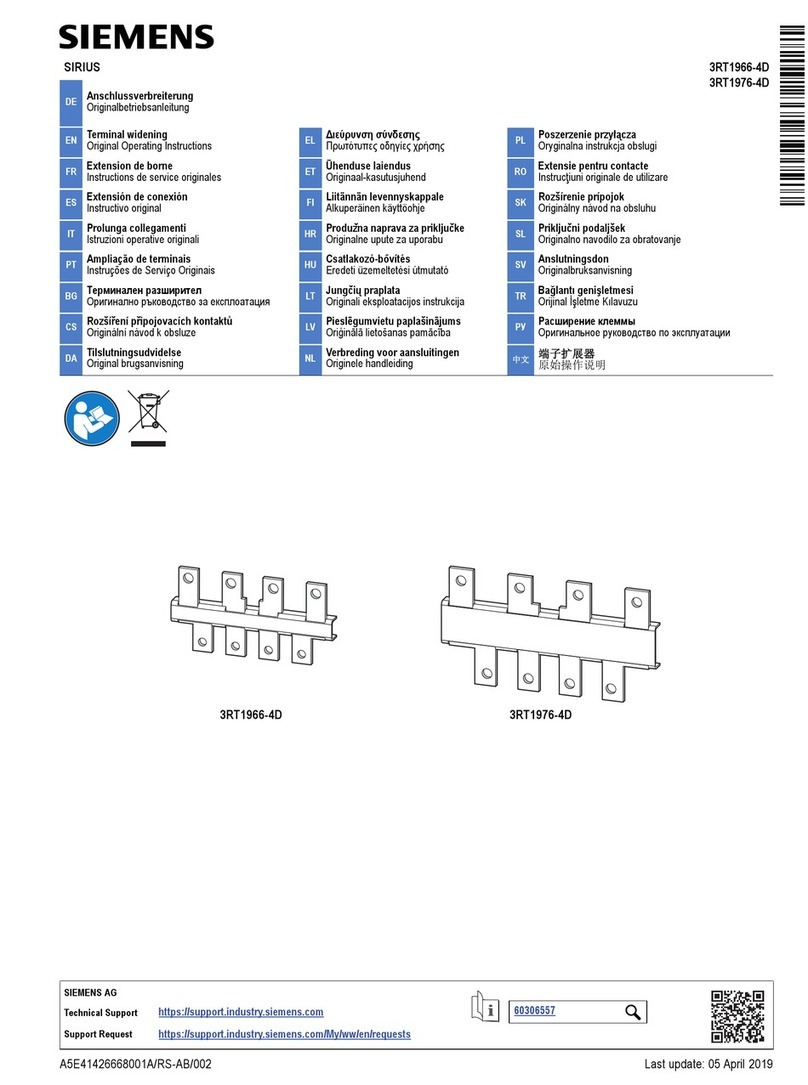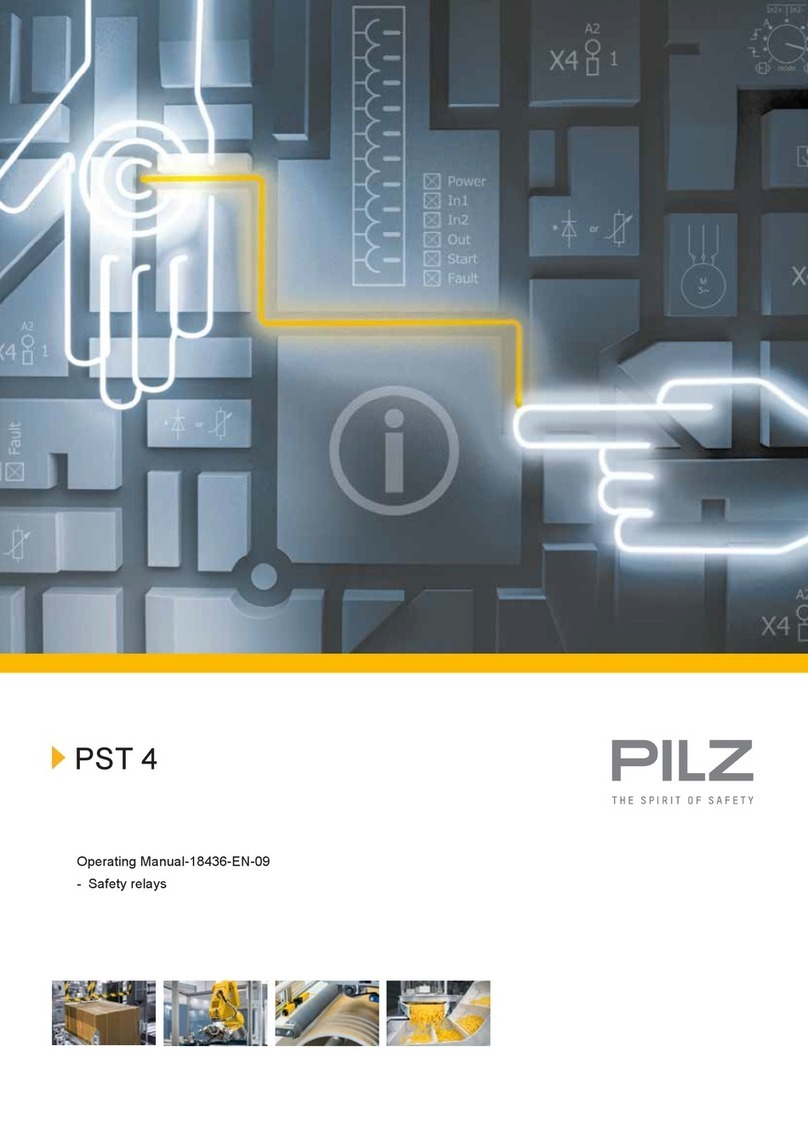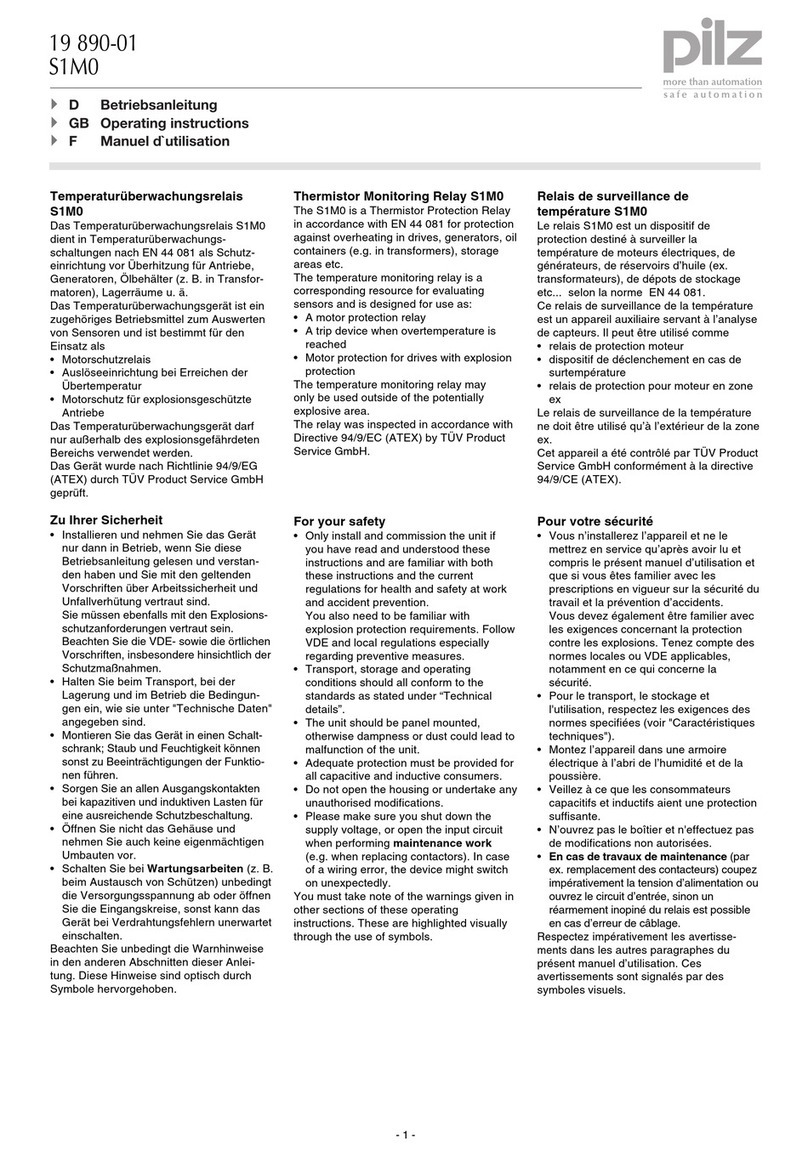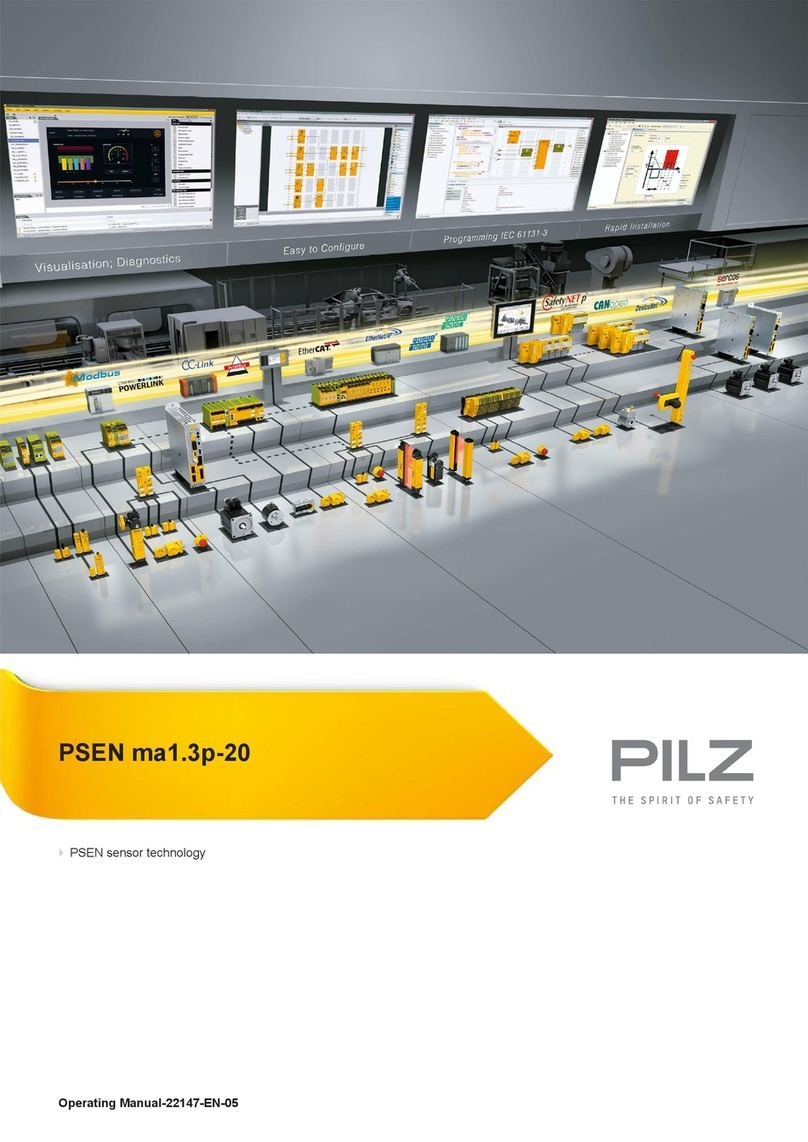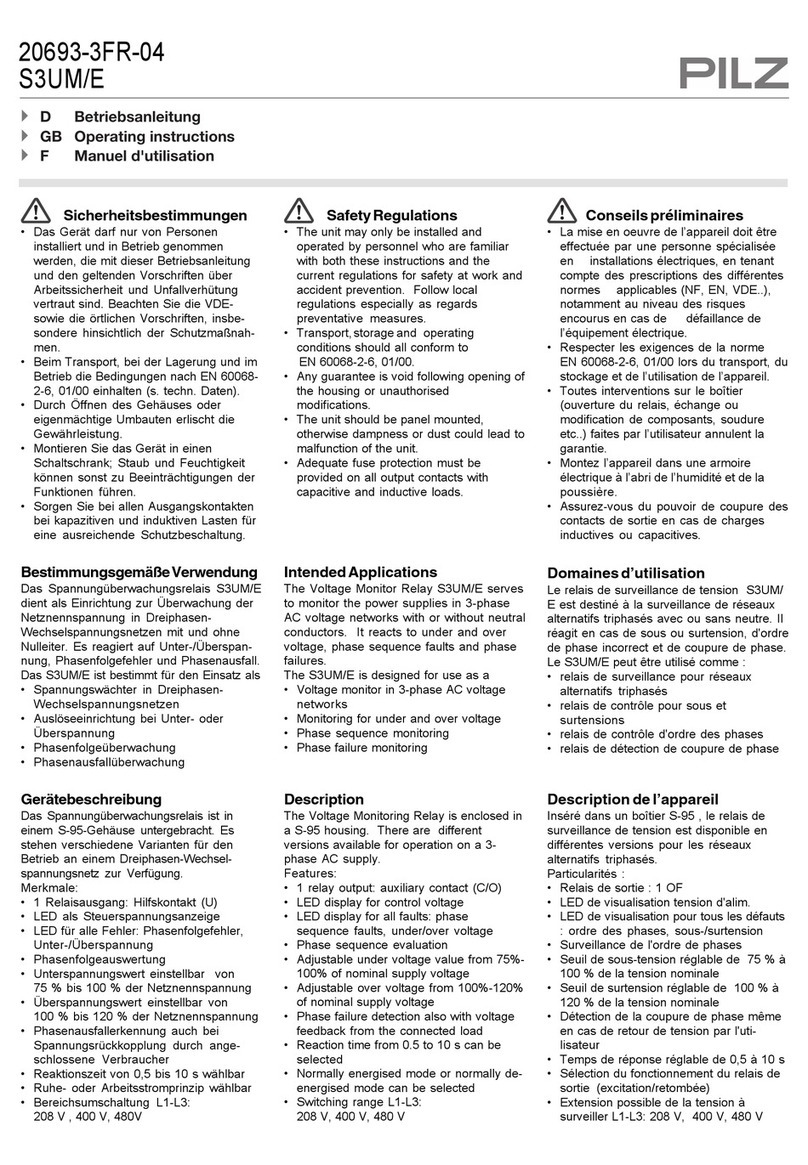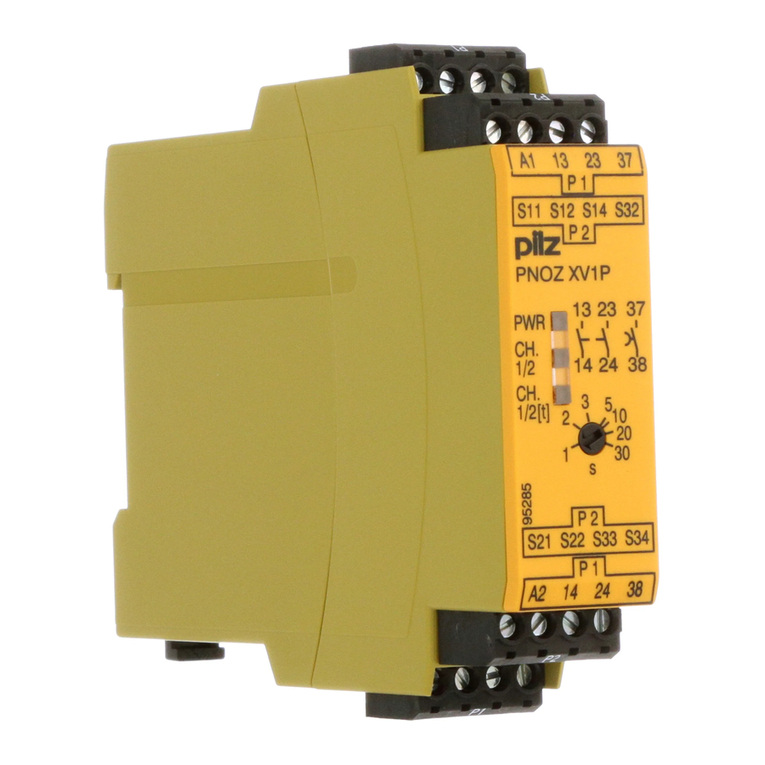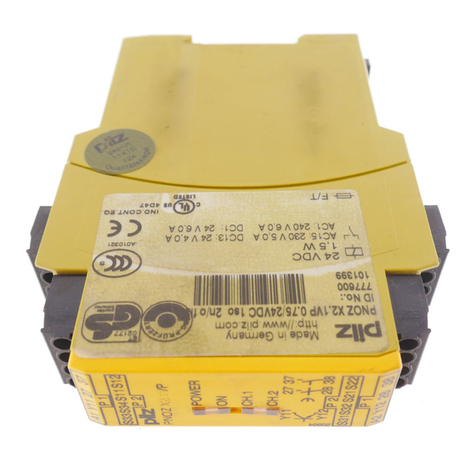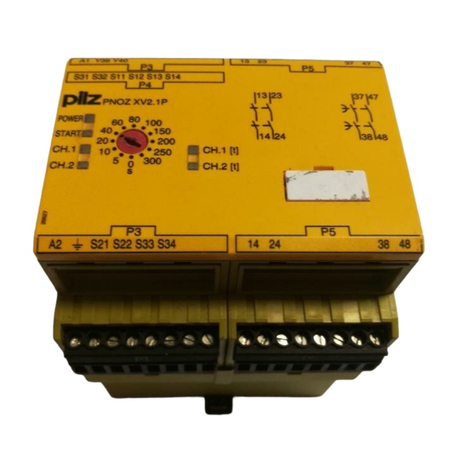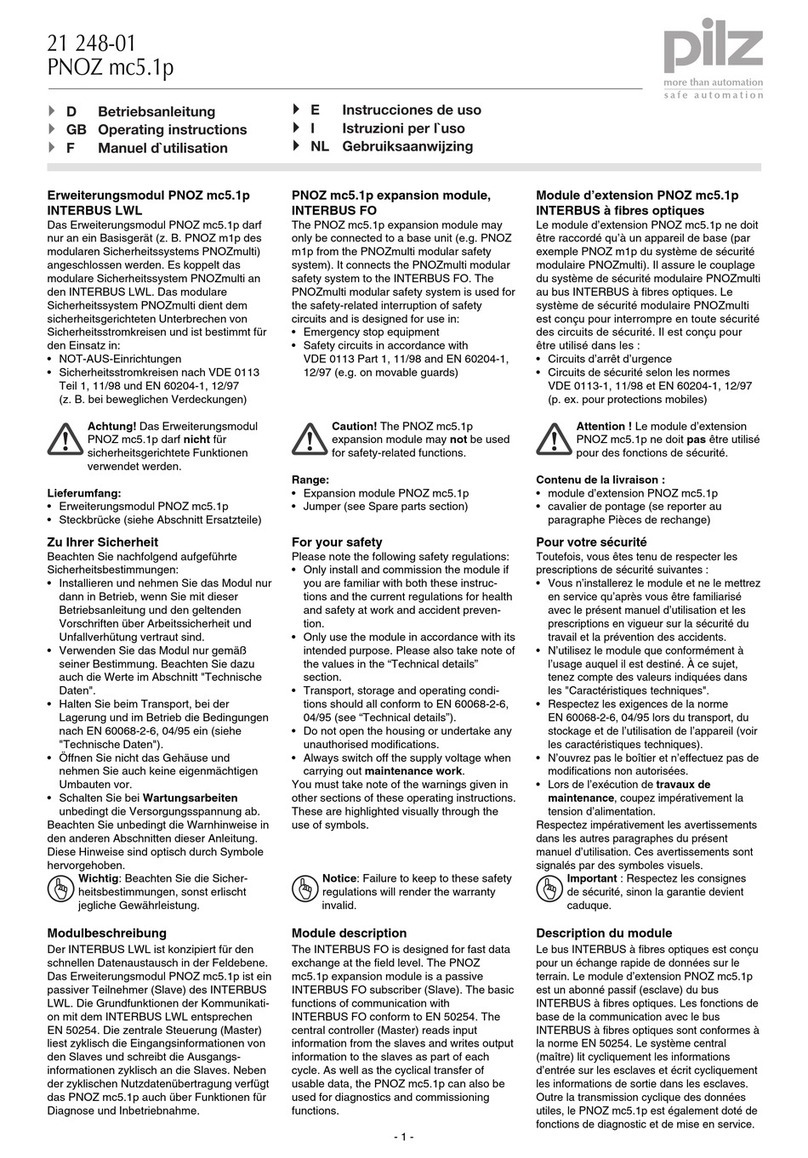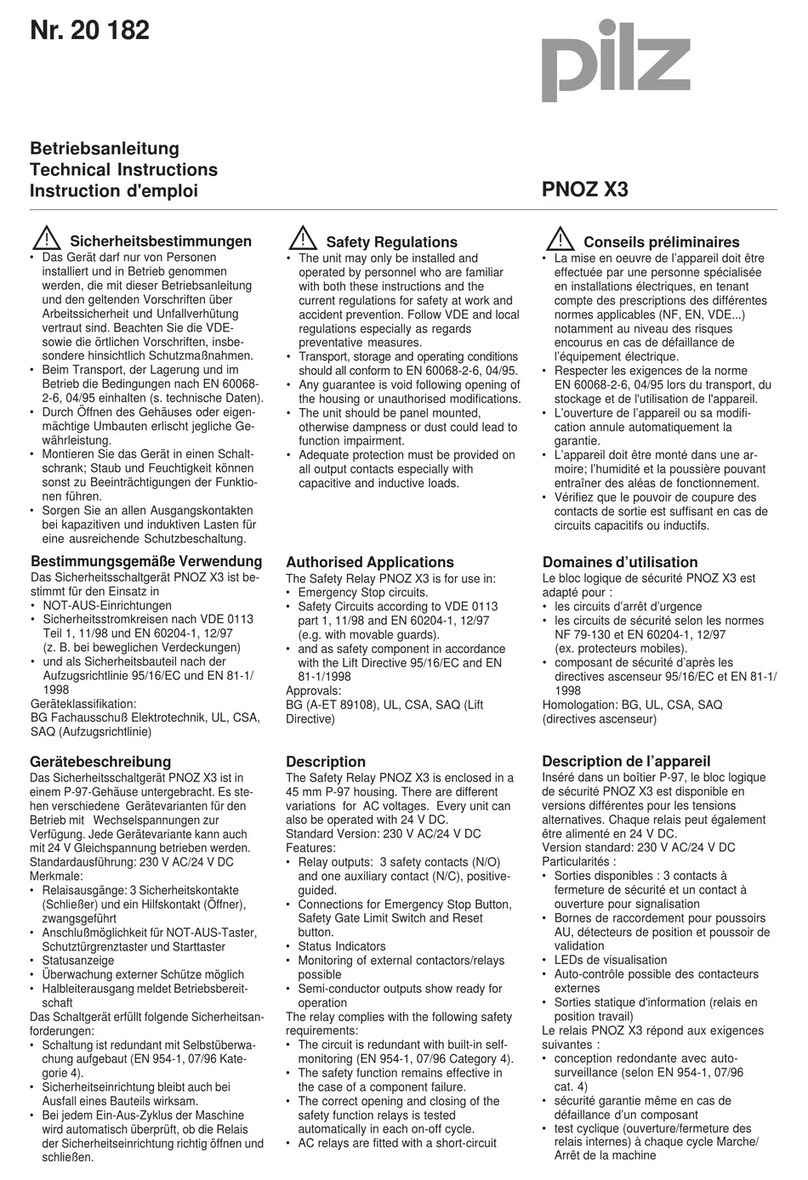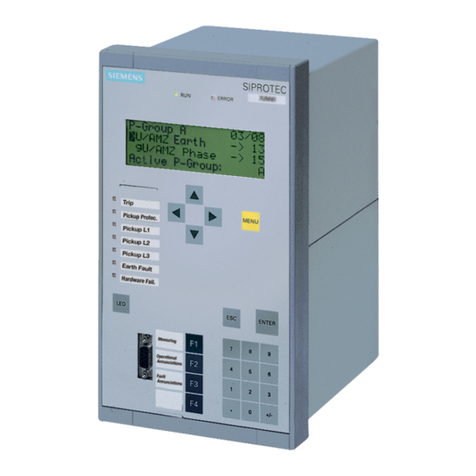
- 4 -
Sicherheitsschaltgerät montieren
Achtung! Durch elektrostatische
Entladung können Bauteile des
Sicherheitssystems beschädigt
werden. Sorgen Sie für Entladung,
bevor Sie das Sicherheitssystem
berühren, z. B. durch Berühren einer
geerdeten, leitfähigen Fläche oder
durch Tragen eines geerdeten
Armbands.
• Montieren Sie das Sicherheitsschaltgerät
in einen Schaltschrank mit einer Schutz-
art von mindestens IP54.
• Befestigen Sie das Gerät mit Hilfe des
Rastelements auf der Rückseite auf einer
Normschiene.
• Sichern Sie das Gerät auf einer senk-
rechten Normschiene (35 mm) durch ein
Halteelement (z. B. Endhalter oder
Endwinkel)
Achtung!
UND-/ODER- Verknüpfung:
• Montieren Sie alle über die UND-/
ODER- Eingänge verknüpften
Geräte im gleichen Schaltschrank
oder
• Stellen Sie sicher, dass Fehler
über die Verbindung der Geräte
ausgeschlossen werden z.B.
durch geschützte Verlegung der
Verbindungsleitung.
Sicherheitsschaltgerät in Betrieb
nehmen
Inbetriebnahme vorbereiten
Beachten Sie bei der Vorbereitung der
Inbetriebnahme:
• Das Gerät und die Eingangskreise müssen
immer aus einem Netzteil versorgt werden.
• Verwenden Sie Leitungsmaterial aus
Kupferdraht mit einer Temperaturbe-
ständigkeit von 60/75°C.
• Berechnung der max. Leitungslänge Imax
am Eingangs-, Start und Rückführkreis:
R
lmax
R
l
/ km
I
max
=
Rlmax = max. Gesamtleitungs-
widerstand (s. technische Daten)
Rl/km = Leitungswiderstand/km
• Ausgang 14, 24: bei Leerlauf eine
Kapazität bis max. 2 nF ansteuerbar
• Setzen Sie die Sicherheitsausgänge 14
und 24 ausschließlich für sichere
Anwendungen ein. Die Sicherheits-
ausgänge dürfen nicht mit SPS-Eingän-
gen verbunden werden.
Um die Ausschaltimpulse an den
Halbleiterausgängen 14 und 24 zu
unterdrücken, setzen Sie die Reihen-
klemme mit Filter Bestellnummer 774195
oder 774196 ein.
• Die Ausgänge Y32 und Y33 sind Hilfsaus-
gänge z. B. für die Kommunikation mit
einer SPS oder einer Anzeige.
• Verwenden Sie Freilaufdioden, wenn Sie
mit den Sicherheits-/Hilfsausgängen
Schütze oder Relais ansteuern.
• Sorgen Sie beim Anschluss von magne-
tisch wirkenden, auf Reedkontakten
basierenden Näherungsschaltern dafür,
dass der max. Einschaltspitzenstrom (am
Eingangskreis) den Näherungsschalter
nicht überlastet.
Installing the safety relay
Caution! Electrostatic discharge can
damage components on the safety
system. Ensure against discharge
before touching the safety system,
e.g. by touching an earthed,
conductive surface or by wearing an
earthed armband.
• Install the safety relay in a control cabinet
with a minimum protection type of at least
IP54.
• Use the notch on the rear of the unit to
attach it to a DIN rail.
• Attach the unit securely to a vertical DIN
rail (35 mm) using a fixture such as a
retaining bracket or end angle.
Caution!
AND-/OR connection:
• Install all the devices that are
linked via the AND/OR inputs in
the same control cabinet
or
• make sure that faults that occur
from the connection of the
devices can be excluded, e.g. by
secure laying of connection
cables.
Installer le bloc logique de sécurité
Attention ! Une décharge électro-
statique peut endommager les
éléments du système de sécurité.
Veillez à vous décharger avant de
toucher le système de sécurité, par
ex. en touchant une surface
conductrice mise à la terre ou en
portant un bracelet de mise à la
terre.
• Installez le bloc logique de sécurité dans
une armoire d'indice de protection IP54
au moins.
• Montez l’appareil sur un rail normalisé à
l’aide du système de fixation situé au dos
de l'appareil.
• Immobilisez l’appareil monté sur un rail
DIN vertical (35 mm) à l’aide d’un élément
de maintien comme par ex. un support ou
une équerre terminale.
Attention!
Liaison ET/OU :
• Montez l'ensemble des appareils
reliés via les entrées ET/OU dans
la même armoire électrique
ou
• assurez-vous que la connexion
des appareils n'entraîne pas
d'erreurs, en protégeant, par
exemple, les câbles de
raccordement entre les appareils.
Mettre en service le bloc logique de
sécurité
Préparation de la mise en service
Pour préparer la mise en service, respectez
les consignes suivantes :
• L’appareil et les circuits d’entrée doivent
toujours être reliés à la même source
d’alimentation.
• Utilisez des fils de câblage en cuivre
supportant des températures de 60/75 °C.
• Calcul de la longueur de conducteur Imax
sur le circuit d’entrée, de réarmement et
sur la boucle de retour :
R
lmax
R
l
/ km
I
max
=
Rlmax = résistance de câblage totale
max. (voir les caractéristiques
techniques)
Rl/km = résistance du câble/km
• Sorties 14, 24 : en cas de fonctionnement
à vide, une capacité max. de 2 nF peut
être contrôlée.
• Utilisez les sorties de sécurité 14 et 24
uniquement dans des circuits de sécurité.
Les sorties de sécurité ne doivent pas
être raccordées à des entrées d’API.
Pour supprimer l'impulsion de coupure
aux sorties statiques 14 et 24, utilisez les
bornes avec filtre, référence 774195 ou
774196.
• Les sorties Y32 et Y33 sont des sorties
d’information pour la communication par
exemple avec un API ou un affichage.
• Utilisez des diodes de roue libre lorsque
vous commandez des contacteurs ou des
relais au moyen des sorties de sécurité/
d’information.
• Lors du raccordement de détecteurs de
proximité magnétiques, basés sur des
contacts Reed, veuillez vous assurer que
le courant de crête max. à la mise sous
tension (sur le circuit d'entrée) ne
surcharge pas les détecteurs de
proximité.
Commissioning the safety relay
Preparing for commissioning
Please note the following when preparing
for commissioning:
• Power for the unit and the input circuits
must always be provided from a single
power supply.
• Use copper wire that will withstand
temperatures of 60/75 °C.
• Calculating the max. cable length Imax at
the input, reset and feedback circuit:
R
lmax
R
l
/ km
I
max
=
Rlmax = max. overall cable resistance
(see "Technical details")
Rl/km = cable resistance/km
• Output 14, 24: at no-load, a capacitance
of max. 2 nF can be driven
• Safety outputs 14 and 24 should be used
exclusively for safe applications. The
safety outputs must not be connected to
PLC inputs.
In order to suppress the pulses on switch-
off on the semiconductor outputs 14 and
24, the terminal block with filter, order
number 774195 or 774196 should be
used.
• Outputs Y32 and Y33 are auxiliary
outputs, e.g. for communication with a
PLC or text display.
• Use flywheel diodes to drive contactors or
relays with the safety/auxiliary outputs.
• When connecting magnetically operated,
reed proximity switches, ensure that the
max. peak inrush current (on the input
circuit) does not overload the proximity
switch.
